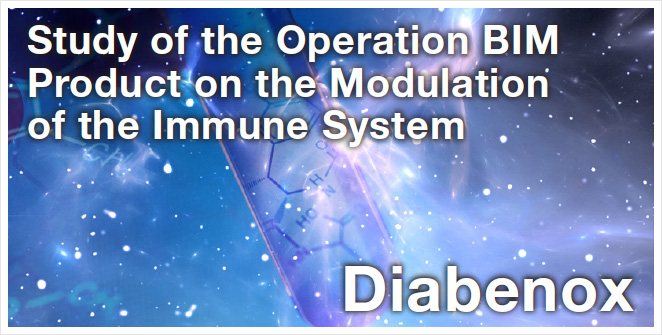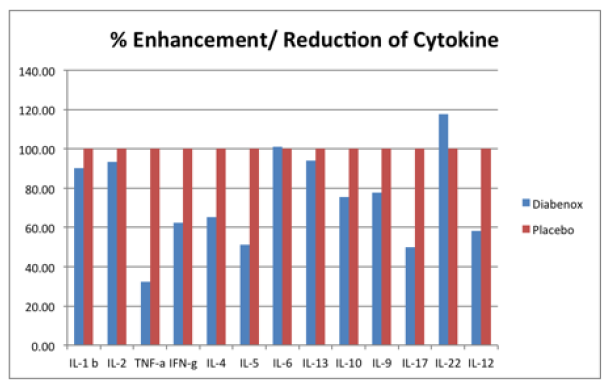Study of the Operation BIM Product on the Modulation of the Immune System (Diabenox)

During the last decades, the development of specific agents affecting T helper cell subpopulations, i.e., Th1, Th2, and Th17, differentiation has drawn special attention. Many natural products have been reported as effective agents for modulating the immune response by regulating the differentiation of T helper cell subpopulations. These products have the potential to serve as the immunostimulants for the treatment of various diseases, including infectious diseases, cancers, autoimmune diseases, and also diabetes.
In this study, we aim to study the immunomodulatory effects of the Operation BIM product. We investigated the possible effects of the Operation BIM product on controlling T helper cell subpopulation differentiation.
Objective
The objective of this study is to investigate the possible effects of the Operation BIM product on the regulation of T helper cell subpopulations. The levels of various cytokines in blood collected from healthy donors before and after taking the Operation BIM product for 15 days were compared.
Study approach:
1. Study subjects
• 12 healthy volunteers: 7 males and 5 females
• Age: 20-50 years old
• The recruited volunteers were separated into 2 groups:
o Group 1: taking placebo; 6 subjects
o Group 2: taking Operation BIM product; 6 subjects
2. Blood collections
Blood (5 ml using heparin as an anticoagulant) was collected from each subject on day 0. Depending on their group, subjects took the Operation BIM product or placebo (4 capsules/day) every day for 15 days. Subsequently, blood was collected (5 ml using heparin as an anticoagulant) for the second time on day 16.
3. Study of the effects of the Operation BIM product on the regulation of T helper cell subpopulations
Peripheral blood mononuclear cells (PBMCs) were isolated from the collected blood using Ficoll-Hypaque gradient centrifugation. PBMCs were in vitro stimulated with or without anti-CD3 monoclonal antibodies (clones OKT3) and cultured for 24 hours at 37°C in a CO2 incubator. The cell culture supernatants were collected and centrifuged at 20,000 rpm for 2 minutes. The cell-free supernatants were separated and stored at -70°C for the determination of cytokines.
4. Determination of T helper cell cytokines
Cytokines in the cell culture supernatants were determined by Flow CytomixÒ (eBioscience, Inc. San Diego, CA, USA) following the manufacturer’s protocol. Comparisons of the cytokine levels from un-stimulated PBMC and stimulated PBMC in terms of Stimulation Index on day 0 and day 15 were performed.
Results
The stimulation indexes of various cytokines in subjects taking the Operation BIM product and placebo were calculated and compared. After normalization using subjects taking placebo, the % enhancement and reduction of subjects taking the Operation BIM product were shown in the figure below. The results indicate that the Operation BIM product reduced the production of TNF-a, IFN-g, IL-4, IL-5, IL-9, IL-10, IL-12 and IL-17.

In type 2 diabetes, which is usually associated with obesity or older age, diabetes is mostly the result of insulin resistance. In these patients, the muscle or adipose cells do not respond adequately to the normal levels of insulin produced by intact beta-cells. On the other hand, Type 1 diabetes usually starts in people younger than 30 and is, therefore, also termed juvenile-onset diabetes, even though it can occur at any age. Type 1 diabetes is a chronic autoimmune disorder that develops in genetically susceptible individuals due to environmental factors (1). The body’s own immune system attacks the beta-cells in the islets of Langerhans of the pancreas, destroying or damaging them sufficiently to reduce and eventually eliminate insulin production. A number of factors, including a Th1-skewed CD4+ response as well as a deficiency of regulatory T cells, are considered to be important hallmarks of disease progression (2)."
Several pieces of information suggest that Th1 cells play a major role in diabetes, driving the development of the disease via IFN-γ (3). This information includes the observations that the blockade of IFN-γ (4) or the absence of STAT4 (5, 6) prevents the disease, whereas IL-12 promotes accelerated diabetes (7). Tumor necrosis factor alpha (TNF-α) has well-described effects on lipid metabolism in the context of acute inflammation, as in sepsis. Recently, increased TNF-α production has been observed in adipose tissue derived from obese rodents or human subjects, and TNF-α has been implicated as a causative factor in obesity-associated insulin resistance and the pathogenesis of type 2 diabetes. Thus, current evidence suggests that administration of exogenous TNF-α to animals can induce insulin resistance, whereas neutralization of TNF-α can improve insulin sensitivity (8). In addition, TNF-α shows a significant positive association with insulin secretory capacity when adjusting for the effects of confounding factors – age, sex, and BMI in IGR subjects. Thus, there may be a causal relationship between TNF-α and insulin secretory defects in prediabetic and IGR subjects (9).
Th17 immunity has been demonstrated in the development of autoimmune diabetes in animal models. In NOD mice, a model of spontaneous autoimmune diabetes, inhibition of Th17 cells has been shown to regulate autoimmune diabetes (10). IL-17 neutralization, either by anti-IL-17 or by rIL-25, prevented the development of autoimmune diabetes when given from 10 weeks of age to NOD mice (11). Earlier treatment from 5 weeks of age did not alter diabetes progression, which suggests that Th17 immunity contributes to the progression of autoimmune diabetes during the effector phase of the disease. Natalia et al. differentiated islet-reactive BDC2.5 TcR transgenic CD4+ cells in vitro into Th17 cells and transferred them into NOD.scid and neonate NOD mice. NOD.scid recipient mice developed a rapid onset of diabetes with extensive insulitic lesions, whereas in newborn NOD mice, despite extensive insulitis, most recipient mice did not develop diabetes. Surprisingly, BDC2.5+ cells recovered from diabetic NOD.scid mice, in comparison with those from neonate NOD mice, showed a predominant IFN-γ over IL-17 expression, indicating the conversion of donor cells into Th1 cells. Moreover, diabetes progression in NOD.scid recipients was dependent on IFN-γ, while anti-IL-17 treatment reduced insulitic inflammation. These results indicate that islet-reactive Th17 cells promote pancreatic inflammation, but only induce IDDM upon conversion into IFN-γ producers.
In our study, we have demonstrated that the Operation BIM product has immunomodulatory effects. The product reduced the production of TNF-α, IFN-γ, IL-12, and IL-17, which are involved in the induction of diabetes and disease progression. Reduction of these cytokines may prevent the development of diabetes and improve the quality of life for patients.
References
1. Atkinson MA, Eisenbarth GS. Type 1 diabetes: new perspectives on disease pathogenesis and treatment. Lancet. 2001;358: 221–229.
2. Anderson MS, Bluestone JA. The NOD mouse: a model of immune dysregulation. Annu. Rev. Immunol. 2005;23: 447–485.
3. Wang B, et al. Interferon-gamma impacts at multiple points during the progression of autoimmune diabetes. Proc. Natl. Acad. Sci. U.S.A. 1997;94:13844-13849.
4. Nicoletti F, et al. The effects of a nonimmunogenic form of murine soluble interferon-gamma receptor on the development of autoimmune diabetes in the NOD mouse. Endocrinology. 1996;137:5567-5575.
5. Boyton RJ, et al. Stat4-null non-obese diabetic mice: protection from diabetes and experimental allergic encephalomyelitis, but with concomitant epitope spread. Int. Immunol. 2005;17:1157-1165.
6. Yang Z, et al. Autoimmune diabetes is blocked in Stat4-deficient mice. J. Autoimmun. 2004;22:191-200.
7. Trembleau S, et al. Interleukin 12 administration induces T helper type 1 cells and accelerates autoimmune diabetes in NOD mice. J. Exp. Med. 181:817-821, 1995 .
8. Moller DE. Potential role of TNF-alpha in the pathogenesis of insulin resistance and type 2 diabetes. Trends Endocrinol Metab. 11(6):212-7, 2000.
9. Mosaraf Hossain, M Omar Faruque, Golam Kabir , Naimul Hassan, Dwaipayan Sikdar, Quamrun Nahar, Liaquat Ali. Association of serum TNF-α and IL-6 with insulin secretion and insulin resistance in IFG and IGT subjects in a Bangladeshi population. International Journal of Diabetes Mellitus. Vol. 2, Issue 3, P.165-168, December 2010.
10. Jain R, et al. Innocuous IFNgamma induced by adjuvant-free antigen restores normoglycemia in NOD mice through inhibition of IL-17 production. J. Exp. Med. 2008; 205: 207–218.
11. Emamaullee JA, et al. Inhibition of Th17 cells regulates autoimmune diabetes in NOD mice. Diabetes. 2009;58:1302-1311.
12. Martin-OrozcoN, et al. Th17 cells promote pancreatic inflammation but only induce diabetes efficiently in lymphopenic hosts after conversion into Th1 cells. Eur. J. Immunol. 2009;39(1): 216–224.
Report by:
Professor Dr. Watchara Kasinrerk, Ph.D.
Director, Biomedical Technology Research Center,
Faculty of Associated Medical Sciences,
Chiang Mai University,
Chiang Mai 50200, Thailand